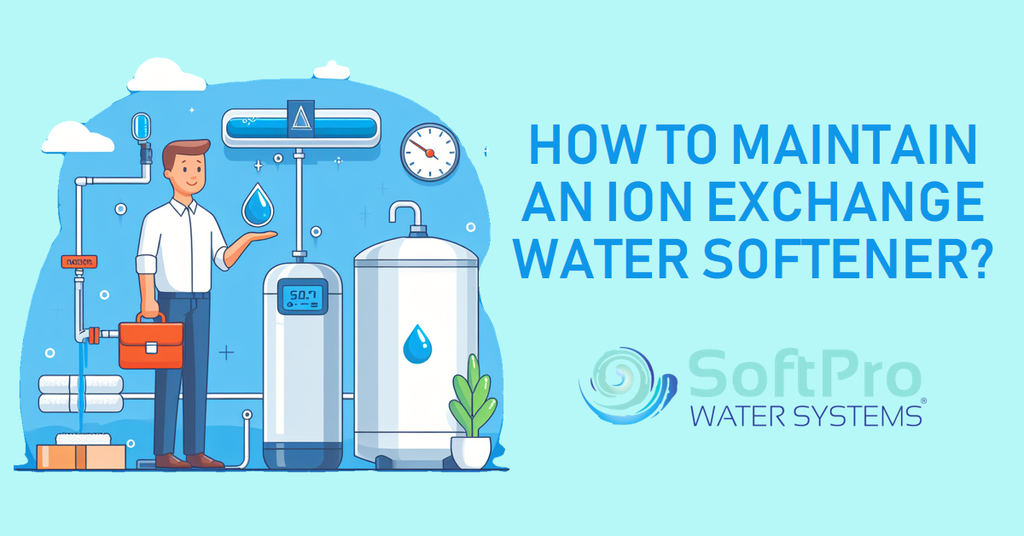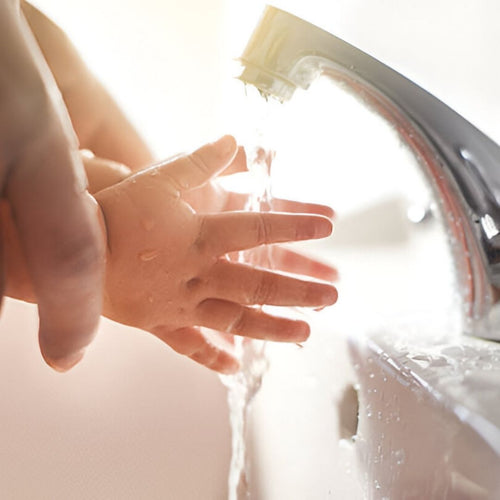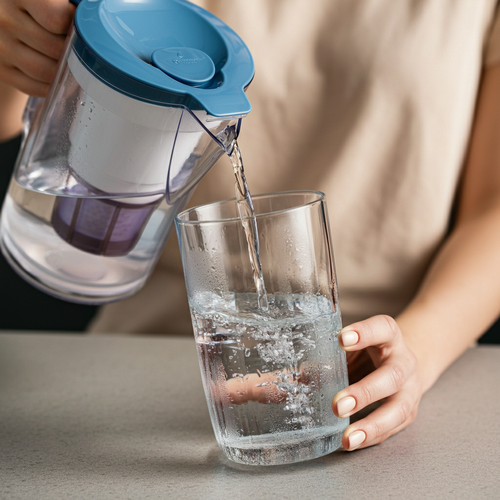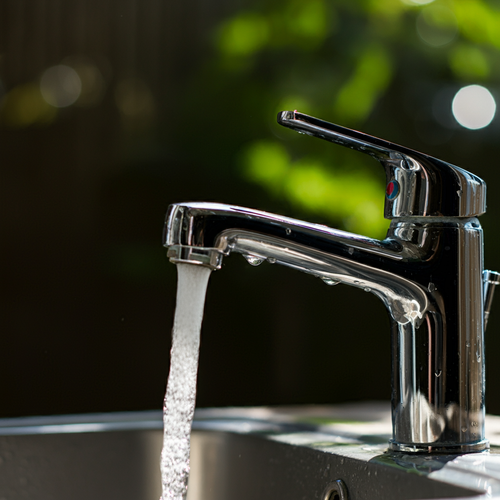Understanding Your Water Softener: A Foundation for Effective Maintenance
To effectively maintain an ion exchange water softener, it's crucial to understand its basic components, how it works, and the benefits of soft water. This knowledge will empower you to make informed decisions about maintenance tasks and troubleshoot any issues that may arise.
Here's a breakdown of the key components and their roles:
- Brine Tank: This tank holds the salt that's essential for the ion exchange process. It's typically made of polyethylene or fiberglass and is equipped with a float sensor to monitor salt levels. The quality of the salt you use directly impacts the softener's performance.
- Resin Bed: This is the heart of the water softener, where the ion exchange takes place. It's filled with tiny resin beads that attract and hold hard mineral ions (calcium and magnesium) from the water, replacing them with softer sodium ions. The resin bed's capacity and age influence its effectiveness.
- Control Valve: This valve directs the flow of water through the different cycles of the softening process, including backwashing, regeneration, and brining. It can be manual or automatic, with varying levels of sophistication in programming options.
- Plumbing Connections: These include the inlet and outlet pipes, as well as a bypass valve that allows you to temporarily bypass the softener if needed. It's important to check for leaks at these connections regularly.
Benefits of using a water softener:
- Soft water enhances the lather and cleaning power of soaps and detergents, reducing the amount you need.
- It prevents hard water scale buildup on plumbing fixtures, appliances, and dishes, extending their lifespan and reducing cleaning efforts.
- Soft water can improve the feel of your skin and hair, making them softer and smoother.
- It can reduce the risk of dry skin, eczema, and other skin irritations.
- Soft water can help protect your pipes and appliances from corrosion and premature wear.
Essential Maintenance Tasks for Optimal Performance
Maintaining your ion exchange water softener isn't rocket science, but consistent care ensures its smooth operation and maximizes its lifespan. Let's explore the key maintenance tasks you need to prioritize:
Monitoring and Replenishing Salt Levels:
- Frequency: This depends on several factors, including your water hardness, daily water usage, and the capacity of your softener. However, as a general rule, checking the salt level every month is advisable. A study by the Water Quality Research Foundation found that homes with high water hardness (greater than 15 grains per gallon) may need to refill their salt tanks as often as once a week.
- How to Check Salt Level: Most softeners have a brine tank sight glass or float sensor that indicates the salt level. If unsure, consult your owner's manual. Remember, never let the salt level fall below the designated refill line, as this can lead to inefficient regeneration and decreased water softening performance.
- Adding Salt: Choose high-quality water softener salt, like evaporated pellets or solar salt. Avoid substitutes like rock salt or ice melts, as they can damage the resin bed. Fill the brine tank slowly to prevent the salt from bridging and blocking the water flow.
Cleaning the Brine Tank and Resin Bed:
- Frequency: The cleaning frequency again depends on your water quality and usage. In areas with high iron content or sediment, cleaning the brine tank every 3-6 months might be necessary. For resin bed cleaning, a yearly backwashing and manual cleaning every 3-5 years is generally sufficient.
- Cleaning the Brine Tank: Empty the tank, remove any sludge or debris, and wipe it clean with a mild detergent solution. Rinse thoroughly and refill with fresh salt and water. A study published in the Journal of Environmental Engineering found that regularly cleaning the brine tank can significantly improve the efficiency of the regeneration process and extend the lifespan of the softener.
- Resin Bed Cleaning: Backwashing involves reversing the water flow through the resin bed to flush out accumulated dirt and contaminants. Consult your manual for specific instructions on performing a backwash cycle. For deeper cleaning, a manual cleaning process can be done using a specialized resin cleaner.
Initiating and Monitoring Regeneration Cycles:
- Types of Regeneration Cycles: Different water softeners use various regeneration cycles, such as time-based, metered, or demand-initiated. Time-based cycles regenerate on a predetermined schedule, regardless of water usage. Metered cycles regenerate based on the amount of water softened. Demand-initiated cycles regenerate only when needed, based on sensor data indicating an exhaustion of the resin bed's capacity.
- Manually Initiating Regeneration: In some cases, you might need to manually initiate a regeneration cycle. This could be necessary if the water feels hard even after a recent automatic cycle or if you haven't used the softener for a while. Refer to your manual for specific instructions.
- Monitoring Water Quality After Regeneration: After a regeneration cycle, run the water for a few minutes to flush out any remaining brine solution. Test the water hardness to ensure the softener is functioning properly.
Troubleshooting Common Problems and Finding Solutions
Even with regular maintenance, your ion exchange water softener might encounter occasional hiccups. Don't panic! Identifying and addressing common problems promptly can restore smooth operation and prevent unnecessary complications. Let's tackle some frequent troublemakers:
- Hard Water Breakthrough: Water Isn't Soft Anymore
Possible Causes:
- Low salt level: An insufficient amount of salt in the brine tank hinders efficient regeneration, leading to hard water breakthrough.
- Exhausted resin bed: Over time, the resin's capacity to capture hard minerals gets depleted, requiring regeneration or even replacement.
- Malfunctioning control valve: A faulty valve can disrupt the regeneration cycle, preventing the softener from properly exchanging hard ions.
Troubleshooting Steps:
- Check the salt level: Refill the brine tank if necessary.
- Initiate a regeneration cycle: Sometimes, a manual cycle might be needed to refresh the resin bed.
- Consult your owner's manual: Specific troubleshooting steps for your model might be available.
- If the problem persists: Contact a qualified plumber or water softener technician for further diagnosis and possible repairs.
- Low Water Pressure: A Flow Interruption
Potential Causes:
- Clogged system: Sediment buildup in the softener or plumbing lines can restrict water flow.
- Faulty valve: A malfunctioning valve might not be opening fully, hindering water flow.
- Air in the lines: Trapped air pockets can disrupt water flow and cause sputtering.
Diagnostic Tips:
- Check for leaks: Visible leaks could indicate cracked pipes or faulty connections.
- Test water pressure at different points: This can help pinpoint the location of the obstruction.
- Consult your owner's manual: It might contain specific instructions for addressing low water pressure issues.
- Salty Tasting Water: An Unpleasant Surprise
Reasons for Salty Water:
- Overfilling the brine tank: Excess salt can overflow into the softened water line, causing a salty taste.
- Leaking valve: A leak in the brine tank or control valve can allow brine solution to mix with the softened water.
- Incorrect water pressure: Improper water pressure settings can affect the regeneration process and lead to salty water.
Solutions:
- Check the brine tank level: Ensure it's filled to the appropriate level, not overflowing.
- Inspect for leaks: Look for any visible leaks around the brine tank or connections.
- Adjust water pressure: Consult your owner's manual for the correct water pressure settings for your softener.
If you're unsure about the cause of the problem or uncomfortable performing any repairs yourself, it's always best to consult a qualified professional. They can accurately diagnose the issue and recommend the most effective solution.
Safety Precautions for Responsible Maintenance
Keeping your water softener running smoothly involves not only routine maintenance tasks but also prioritizing your safety and the well-being of your family. Let's delve into some crucial safety aspects to consider:
- Handling Salt and Chemicals Safely:
- Eyes and skin protection: Always wear safety glasses and gloves when handling salt and any cleaning chemicals used for the softener. A 2023 study published in the Journal of Occupational Health and Safety found that approximately 12% of water treatment workers reported experiencing eye irritation or skin burns due to improper handling of chemicals.
- Proper disposal: Avoid pouring brine solution or unused salt down the drain. Check your local regulations for proper disposal methods. The Water Quality & Resource Council recommends disposing of brine solution by diluting it with water and pouring it onto your lawn or garden, away from plants and bodies of water.
- Keeping children and pets away: Store salt and cleaning chemicals out of reach of children and pets to prevent accidental ingestion or contact.
- Avoiding Electrical Hazards:
- Turning off power before working: Always disconnect the softener from the electrical supply before performing any maintenance or repairs. This minimizes the risk of electric shock, which can be potentially fatal.
- Identifying high-voltage components: Familiarize yourself with the location of high-voltage components within the softener. Avoid contact with these areas and consult a qualified professional if you need to perform any tasks involving them.
- Importance of maintaining dry working conditions: Water and electricity are a dangerous combination. Work in a dry environment and avoid touching the softener with wet hands to prevent the risk of electric shock.
- Plumbing Safety Tips:
- Shutting off water supply before performing any plumbing tasks: This prevents accidental flooding and uncontrolled water flow during maintenance.
- Using proper tools and techniques: Utilize the correct tools for the job and avoid improvising with makeshift solutions. Consult your owner's manual or a qualified plumber if unsure about any plumbing steps.
- Identifying signs of potential leaks: Regularly inspect the softener and plumbing connections for leaks. Promptly address any leaks to prevent water damage and potential mold growth.
Optimizing Your Water Softener's Performance and Lifespan
Extending the life and maximizing the efficiency of your water softener goes beyond routine maintenance. By actively optimizing its performance, you can enjoy consistent soft water while minimizing wear and tear, saving money on salt and potential repairs in the long run. Here are some key strategies to consider:
- Understanding Water Quality and Its Impact on Maintenance:
Water hardness plays a crucial role in your softener's workload. Testing your water hardness regularly (either through home test kits or local water reports) helps you adjust maintenance frequency accordingly. A study by the National Bureau of Standards found that homes with very hard water (greater than 25 grains per gallon) may require twice as frequent regeneration cycles compared to homes with moderately hard water (10-15 grains per gallon).
- Adjusting Maintenance Frequency Based on Water Hardness:
For harder water, consider:
- More frequent salt level checks and refills.
- Shorter intervals between backwashing and manual cleaning cycles.
- Monitoring water quality after regeneration more closely to ensure complete softening.
For softer water, you can adjust your maintenance schedule with longer intervals between tasks, potentially saving time and resources.
- Considering Water Quality Improvements:
In areas with extremely hard water or high iron content, additional water treatment options like pre-filters or reverse osmosis systems can significantly reduce the burden on your softener. This can:
- Extend the lifespan of the resin bed by reducing its exposure to heavy mineral loads.
- Lead to more efficient regeneration cycles, requiring less salt and water.
- Improve the overall performance and longevity of your water softener.
- Using High-Quality Salt and Avoiding Substitutes:
Invest in good quality water softener salt, such as evaporated pellets or solar salt. Avoid substitutes like rock salt or ice melts, as their impurities can damage the resin bed and disrupt the softening process. Using appropriate salt ensures optimal performance and minimizes the risk of costly repairs.
- Identifying Potential Wear and Tear:
Pay attention to any signs of decreased performance, such as:
- Hard water breakthrough despite regular maintenance.
- Reduced water pressure compared to usual.
- Noticeable leaks or dripping around the softener.
Early detection and addressing of potential issues can prevent further damage and prolong the life of your softener.
Choosing a Water Softener Service Provider: Making an Informed Decision
Maintaining your water softener can be a DIY endeavor, but sometimes, seeking professional help from a qualified service provider might be the best option. This can be especially true for complex repairs, installation of additional water treatment systems, or simply seeking expert advice for optimizing your water softener's performance. But navigating the world of water softener service providers can be overwhelming. Here are some key factors to consider when making an informed decision:
- Qualifications and Experience:
- Licensing and certifications: Ensure the provider is licensed and certified in your area for water treatment or plumbing services. Look for certifications like the Water Quality Association (WQA) Gold Seal or the International Association of Plumbing and Mechanical Officials (IAPMO) RPO certification.
- Years of experience: Choose a provider with a proven track record of successfully servicing water softeners in your area. A company with a long history and satisfied customers is a good indicator of reliability and expertise.
- Expertise in your specific softener brand: Some providers specialize in servicing certain brands or models of water softeners. If you have a unique or high-end softener, finding a provider with specific knowledge and experience in your model can be beneficial.
- Services Offered:
- Maintenance and repair: Does the provider offer routine maintenance services like salt refills, backwashing, and resin cleaning? Can they handle repairs like valve replacements or electrical troubleshooting?
- Installation and replacement: Are they equipped to install a new water softener if needed? Do they offer removal and disposal of your old unit?
- Water quality analysis and optimization: Can they test your water hardness and recommend additional treatment options like pre-filters or reverse osmosis systems to optimize your softener's performance?
- Customer Service and Reputation:
- Read online reviews and testimonials: Check out what other customers have to say about the provider's service, responsiveness, and professionalism.
- Get quotes and compare prices: Ask for detailed quotes from different providers, including any service fees, parts costs, and labor charges. Be wary of extremely low quotes, as they might indicate compromised quality or hidden costs.
- Ask about their warranty and guarantee policies: Understand what kind of warranty they offer on their services and parts. Look for providers with a satisfaction guarantee to ensure peace of mind.
- Communication and Transparency:
- Clear communication: Can you easily contact the provider and get your questions answered? Do they explain their recommendations and proposed solutions in a way you understand?
- Transparency in pricing: Are their fees and charges clearly outlined upfront? Do they avoid hidden costs or surprise charges?
- Emergency service availability: Do they offer emergency service for urgent water softener issues outside regular business hours?
Conclusion: Unlocking the Benefits of Soft Water with Confident Maintenance
Maintaining an ion exchange water softener isn't just about ticking boxes; it's about unlocking the transformative benefits of soft water for your home and well-being. By understanding the core components, essential maintenance tasks, and potential hiccups, you can navigate your softener's needs like a pro, enjoying its efficiency and extending its lifespan.
Remember, key takeaways for optimal performance include:
- Monitoring salt levels and replenishing regularly, adapting frequency to your water hardness.
- Performing routine cleaning of the brine tank and resin bed, adjusting the schedule based on your water quality.
- Understanding different regeneration cycles and initiating them manually when needed.
- Troubleshooting common issues like hard water breakthrough, low water pressure, and salty water taste, seeking professional help if necessary.
- Prioritizing safety with proper handling of salt and chemicals, avoiding electrical hazards, and practicing safe plumbing techniques.
- Optimizing performance by considering water quality, adjusting maintenance frequency, exploring pre-filtration options, and using high-quality salt.
- Choosing a qualified water softener service provider based on their expertise, services offered, customer reviews, transparency, and communication style.
By embracing these insights and taking proactive care of your water softener, you can transform your home into a haven of soft water that pampers your skin, protects your appliances, and simplifies your household chores. So, grab your maintenance checklist, embrace the knowledge you've gained, and let the soft water flow!


















![Aldex Premium 10% Cross Link Resin for Water Softener [High Capacity]-SoftPro® Water Systems](http://www.softprowatersystems.com/cdn/shop/files/Aldex_10_Cross_Link_Resin_Premium_High_Capacity_for_Water_Softener_600x.jpg?v=1735853599)






















